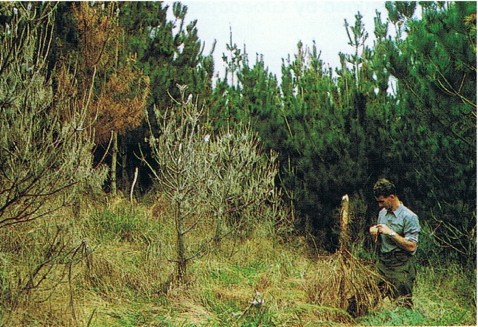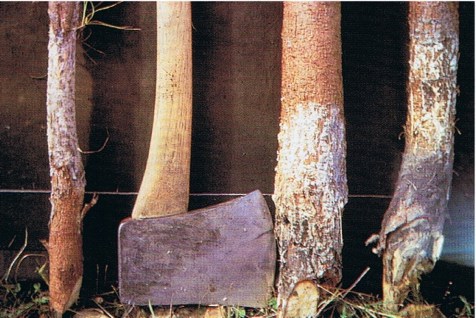PESTS AND DISEASES OF FORESTRY IN NEW ZEALAND
Root rot caused by Gloeocystidiella sacratum
Scion is the leading provider of forest-related knowledge in New Zealand
Formerly known as the Forest Research Institute, Scion has been a leader in research relating to forest health for over 50 years. The Rotorua-based Crown Research Institute continues to provide science that will protect all forests from damage caused by insect pests, pathogens and weeds. The information presented below arises from these research activities.
From Scion publication Forest Research Bulletin 220, An Introduction to The Diseases of Forest and Amenity Trees in New Zealand,
G.S.Ridley and M.A. Dick 2001
(See also Peniophora root and stem canker Forest Pathology in New Zealand No. 3 )
Species: Gloeocystidiella sacratum (syn. Peniophora sacrata; Amylostereum sacratum) (Basidiomycete)
Common name: Glenbervie or peniophora root and stem canker
Country of origin: New Zealand
Host(s): Pathogenic on pines and other trees, and on native shrubland species including: Ageratina, Beilschmiedia, Brachyglottis, Chamaecyparis, Coprosma, Cupressus, Cytisus, Dendrobenthamia, Eucalyptus, Fuchsia, Hakea, Hebe, Kunzea, Leptospermum, Leucopogon, Macropiper, Malus, Melicytus, Meryta, Muehlenbeckia, Passiflora, Pinus, Podocarpus, Pomaderris, Prunus, Prumnopitys, Pseudopanax, Pseudotsuga, Pyrus, Quintinia, Ripogonum, Rosa, Schefflera, Tecomaria, Thuja, Ulex, and Weinmannia. It also occurs widely as a wood decay fungus.
Symptoms: Crowns show yellowing, browning, and reddening of foliage, with younger leaves or needles affected last and slow tree death over 2-3 years; trees are grouped (Fig. 83), with earlier deaths nearer the centre; often scrub plants also die in the mortality patch; cankering at root collar or lower stem; resinosis; white pads of fungal tissue on bark surface (Fig. 84). In young plants disease patches may be confused with frost hollows. Affected pines are grouped in slowly expanding disease centres, with new attack to larger trees nearer the patch margin. Tree mortality stops shortly after canopy closure, at about age 10 years, when the shrub species have died through suppression. However, chronic infection in older trees may occur, with the host showing stunting and seasonal spring chlorosis.

Fig. 83: Dead and dying trees at the margin of a group of Pinus radiata
trees infected with Gloeocystidiella sacratum

Fig. 84: White pads of fungal tissue of Gloeocystidiella sacratum on
bark surface of Pinus radiata
Disease development: Infection occurs by root contact. The role of basidiospores is unknown but they possibly colonise fresh woody material as decay fungi in native vegetation. There is no evidence that the fungus can establish in exotic plantations where it has not previously existed. Gloeocystidiella sacratum may survive on a site, by colonising wood debris in soil, for approximately 30 years and can cause scattered infections in second-rotation plantings. Warmer, wetter sites that have good shrub growth are more susceptible to the disease.
NZ distribution: Widespread, but localised, throughout the country. Historically it has caused disease problems in Glenbervie Forest, Northland, and Rai Valley, Nelson.
Economic impact: Not considered to be of economic importance except where the fungus is more widespread.
Control: Not considered necessary
References: Dick 1983; Gilmour 1959
This information is intended for general interest only. It is not intended to be a substitute for specific specialist advice on any matter and should not be relied on for that purpose. Scion will not be liable for any direct, indirect, incidental, special, consequential or exemplary damages, loss of profits, or any other intangible losses that result from using the information provided on this site.
(Scion is the trading name of the New Zealand Forest Research Institute Limited.)

 Farm Forestry New Zealand
Farm Forestry New Zealand

